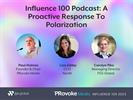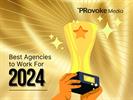Arun Sudhaman 15 Mar 2021 // 8:16AM GMT
.jpg)
Even by the standards of the marketing communications industry, Ogilvy's commitment to transformation has stood out in recent years. In 2017, former CEO John Seifert embarked on a radical 'refounding' that aimed to collapse the giant agency's myriad businesses into one cohesive brand.
That meant the end of the storied Ogilvy PR brand, replaced instead by the 'PR and influence division' of Ogilvy — a move that did not necessarily sit well with the firm's PR leaders, nor its standing in the market. Several of the firm's senior PR executives left, particularly in North America, including global leader Stuart Smith — as the global CEO role, previously held by such names as Marcia Silverman and Chris Graves, was dispensed with.
Fast forward four years and Seifert is gone, replaced by former Deloitte consultant Andy Main, who has signalled yet another shift in strategy. Ogilvy will now be built around five businesses, and Ogilvy PR is back. Most significantly, for our purposes, Main reversed course by bringing in a global CEO for the PR business. The pace of change may not be for the faint of heart but — in former Edelman US chief operating officer Julianna Richter — Ogilvy PR has a new leader who has, at the very least, forged her sterling reputation in a culture of 'organized chaos'.
Indeed, in her first major interview since taking charge, Richter confirms her view that change is nothing more than a constant in this industry, particularly after the past 12 months, and that an outside perspective is often helpful in this regard. Unsurprisingly, she is happy to embrace Main's lofty ambition of tripling the size of Ogilvy PR, which she discusses along with numerous pertinent issues — including acquisition, talent, creativity and structure. The following has been edited for length and clarity.
Arun Sudhaman: You’ve been at Ogilvy for all of two months now. It’s been four years since the 'refounding'. In that period Ogilvy PR as a brand — the idea of Ogilvy PR — has, to some extent, dwindled as it’s been folded inside Ogilvy. We were told, for example, there would be no global CEO hire to replace Stuart Smith. How would you describe the strategy, now that you are in charge? Would you say Ogilvy PR will now become more of a standalone entity?
Julianna Richter: Without a doubt. I think there’s a recognition that despite the intent of bringing all of Ogilvy together several years ago into one Ogilvy, in some places — and Ogilvy PR is a prime example — that might not have been necessarily the right execution and the right way to approach it. The way that PR firms, in general, compete — they compete as independent PR firms against other PR firms. And then they compete as an integrated offering, depending on what the client or the brief is looking for.
So, to combine everything into one Ogilvy did, to a degree, take away what made the brand stand out externally. I understand the thinking behind it, in that you put everything together, and you collapse it and you take away some of the barriers internally, and therefore it should be, in theory, a more integrated offering. I think it doesn’t always end up that way and, in the case of Ogilvy PR, it probably didn’t take into account the ability to compete in the same kind of way. So when I joined and even when I started having conversations about potentially joining, that was definitely a critical piece of what I was looking for — what is the company’s intent to support Ogilvy PR independently and then as an integrated part of the bigger nexus.
You spent many years at Edelman. What was it about this opportunity that interested you, given that when you compare Ogilvy with Edelman, in the US at least, you are talking about quite a difference in terms of scale, in terms of capabilities, in terms of focus. Why take on this challenge?
JR: Well, Ogilvy as a brand, and being a native New Yorker, that is a brand I literally grew up with and watched over the years. And then, when I entered into the professional communications and marketing roles, not only watched it but competed against Ogilvy several times over the course of my career. So the brand itself was what first attracted me. I will say, though, in speaking with [CEO] Andy Main and his vision for having five clear distinct businesses that live and operate and thrive within the Ogilvy construct with the creative heritage that Ogilvy has, that was irresistible to me. That is something that I think is very unique in the marketplace and I’m so happy to say all the things I was hoping were validated when I walked in the door because of the creative strength that the company has that supports those five businesses. So it’s a really unique way of looking at going to market and something for a person like me who’s done this for a few years now — I really was excited about the opportunity we have to build in a different kind of way with that strength behind me.
In the US in particular Ogilvy has lost some key people over the last two to three years and the focus seems to have maybe consolidated around its Washington DC operations. What is your message to the people at Ogilvy who maybe are a little weary of changes in strategy?
JR: I think change is a constant in our industry, and you’d probably agree with that, especially in the world we are living in right now. I’ve seen already a palpable excitement and that’s interesting because I haven’t met most people yet, I’ve been doing this on Zoom since I started. But when I talk to people, there is an excitement about where we’re going forward and there’s a confidence and a belief because Andy Main has put people like me in these roles that that’s making a statement that we are behind all five of these businesses.
There’s a commitment from Ogilvy and there’s a commitment from WPP to really see this through and I think that that is slightly different, maybe, than in the last couple of years. I think that but, more importantly, I’ve heard that from staff. The other thing I think people are excited about is the outside perspective and experts coming in. I think, very often, agencies — and Ogilvy is one of many, Edelman similar — after a while, you have a lot of the same people maybe moving into different roles in the company. But bringing in outside perspective is not only healthy for an organization, it also sends a message that we are looking to do things differently and that is exciting to people as well.
So it’s not just a case of rewinding the clock back to where Ogilvy PR was in 2014, let’s say, because, even in 2014, I think there was a recognition that Ogilvy PR needed something different in the US. What do you think needs to be done differently in the US, as the most important PR market in the world?
JR: What gives me tremendous confidence is the receptivity that we’ve had from the market. And that’s just in the two short months that I’ve been in this role. I don’t say that lightly, by the way. I think that there has been a lot of interest in what Ogilvy has to offer — Ogilvy the brand and then Ogilvy PR in particular. So when I look at that and I see the briefs that are coming in — integrated briefs, stand-alone PR briefs — there is an interest and a desire to work with Ogilvy PR. Now the question is, how do we harness all of that and how do we make sure that we are focusing in the right places? That’s where I’m spending my time right now. Really looking critically at where are we strong, because you build from a position of strength. And then, where are places where, perhaps, we need to really bolster and build out or rethink and reimagine, and there’s a few of those.
A lot of that will be North America, I’m incredibly excited about that. I’m a builder at heart. Every job I’ve ever had, if there was a red thread, it was about building and not necessarily following a blueprint that was created. Creating that blueprint to actually take it forward, so I’m really excited about that, and I think North America is going to be the major focus because it should be. With people like Devika [Bulchandani] and the other leaders of the businesses globally, we are in a great position of strength right now to see a different kind of growth than I think we’ve ever seen before.
If you were to specify areas that you are looking to grow, particularly looking at North America, are we just talking about consumer, corporate, technology, healthcare, or is it more specific than that?
JR: When you put it like that, the sectors of course. So we are going to bolster and build out the corporate and sustainability, purpose, reputation side of the business because there is a market need to do that. We have a great centre of excellence. I want to expand upon that in North America and link that more closely with other parts of the network in Asia and in EMEA.
On the brand side, that space is so interesting in a different way because it’s almost morphing and reinventing because of the pandemic and what we have seen in the last year. There’s new kinds of categories and new disrupters that are emerging. There’s a lot of ability to bring together creative with communications, fuelled by technology, to be able to address some of those challenges and that’s going to be an area that we are going to focus on going forward. We’ve been strong for years in health, we are going to go deeper in tech, food and beverage is another area, and then I would add to that mix the newer lifestyle areas whether it’s retail, luxury, as well.
At Edelman, you were involved in work to try and reorient the agency and make it more integrated. What lessons, perhaps, can you take from that experience that you can apply at Ogilvy?
JR: It’s been very fascinating for me, coming from Edelman where we were, at the time, integrating creative into the PR side of the business. And now, joining a company where it’s creative at the core and integrating communications — so it’s been very interesting to see it from both perspectives. It’s easier to be integrating the communications, and all of what that brings to bear, into and with the creative. In part, that’s because the core of Ogilvy always has been and always will be the creative ethos.
But the other reason why is because clients and prospects that we’re talking to expect that creative is going to be an essential part of every brief and everything that we’re doing. We’re not pushing that boulder up a hill, maybe, in the same way that I think some other agencies might, so that’s been a wonderful experience. When we are getting briefs, when people are talking to us, they are talking to us because they know that we’ll bring that strength of creativity as well as the communications and the sector and the discipline expertise. That's something I think that we can continue to push forward and lead in.
Do you feel you need to rethink job titles, agency models, career pathways? I think many Ogilvy PR offices and offerings around the world do follow that kind of conventional structure.
JR: I’ve never been one that’s so concerned about titles anywhere, in any company. I think the structure is probably the key thing to look at for any company because, if you get the structure right in the way that different experts can come together and play to their strength, but do so where the sum is greater than the parts, that’s where the magic happens. That’s where you get the brilliant ideas that are earned and digital, that you can pull through any medium. So, I don’t personally try to get focused on titles. I look at what is the need from the clients and the brief, and what is the right capability and then structure of the team to make that happen. The good news is I have a lot of that experience from my previous roles of having to bring together different disciplines of teams and so I look at the structure before I look at anything else.
Andy Main recently said that acquisition is on the cards for Ogilvy PR, after a period where there were no acquisitions for a number of years. Are there particular geographies you are looking at, particular practices and sectors?
JR: We are actively looking in several geographies right now — traditional acquisitions that are more of an agency, and also different types of partnerships and relationships that we might want to strike. That is also an interesting area given the world we are in right now. Smaller organisations or small collaborative groups that we may or may not want to consider bringing into the Ogilvy fold. In terms of geographic preference and priority, I think because of what we all have been through in this last year, it’s less about do we need the boots on the ground in this particular market, because now clients are used to seeing us the way we are having this conversation.
So I’m looking at it less through, do I need to build up in Europe or do I need to build up in Latin America or even North America — I’m looking at it as what type of skills do we need to be able to meet the needs of our clients? And, we want very high aspirations to be the preferred partner for growth for our clients. If you look at it through that lens, then what are the areas, skillsets, expertise, technologies, what do we need to be able to do that — that’s guiding us to look at what acquisitions or investments we might be making.
Geographically, do you have any specific plans regarding EMEA and Asia-Pacific? The PR operations at Ogilvy are quite strong in both of those regions, but how do you see Ogilvy PR growing in EMEA and Asia-Pacific?
JR: I think that Asia and EMEA are very, very strong, both in terms of the markets and in terms of depth of expertise across the different disciplines. One of the things I’m a big believer in is, how do we leverage and export that into other parts of the network. So centres of gravity are going to be a key part of what we are looking at. If we are particularly strong in Asia in a few places, which we are, then how do we make sure that we are leveraging that, building that and exporting that out into the rest of the network.
So a big part of the strategy I’m looking at right now is identifying those for each of the regions and doing that in a very focused way that will benefit not only the needs of the clients, but it’s also great for the talent that we have in giving people more of an opportunity to perhaps now not just work in their region or market but across regions, across markets and globally. That’s definitely going to be a part of what we are looking to do. It’s only two months in so I’m still deciding exactly where we are going to go, but I’ve already seen about six different areas where we want to build that out in the next year.
When you say centres of gravity, does that focus, for example, on a specific practice area or would that be around a specific client?
JR: I’m talking about built around capability and category. That said, there’s a whole separate piece of work we’re looking at now that is built around client so that’s also happening at the same time because I think there’s a lot more that we could be doing there. The footprint of the Ogilvy brands, not just Ogilvy PR — there’s a lot more I think we could be doing. From the conversations we’ve been having, there’s a lot of receptivity from the clients who might work with us in one part of the business and are open very much so to working with us in another.
Andy Main also said he envisions tripling the PR division globally. Even if we remove the health business from Ogilvy PR...tripling is quite a big task. It’s akin to what Edelman did in the first decade of this millennium. How realistic do you think that is?
JR: I think the fact that Andy said that on the record speaks to his confidence and his commitment to the PR business, how excited he is about the future, and what he believes can and will happen. That is only exciting and motivating for me as the leader of the PR business, and I would say that most of my team would feel the same way. It is definitely a tall order, but it is doable and I know it’s doable because I’ve seen that kind of growth over other parts of my own career.
Again, I go back to the building blocks of what Ogilvy offers with this unbelievable creative engine. I think that is a differentiator in the marketplace. I’ve seen great creative over my career with Edelman. I’ve never seen creative the way I’ve seen Ogilvy do creative. I’ve just never seen that calibre. It’s a different level and that’s exciting to me because I think that can help us, along with the depth of communications expertise, the sector depth and the modern way we harness technology. That is what’s going to get us to Andy’s vision of tripling the business. The commitment that he’s put behind it and the talent, starting with me, coming onboard, and others that we are going to be announcing in the not too distant future — that will also make sure that we are able to see this through. But I am empowered and motivated by that and I can’t wait to actually have the conversation when we’ve done that.
On the creative engine, as you described it, is there a challenge at all? Because you now have creative roles at PR firms, you have creative divisions. Is that something you will have and will staff, or will it just be something that the Ogilvy advertising business is responsible for? And if that’s the case is that a challenge in terms of attracting creative people to the PR side?
JR: It’s not a challenge in that I think more creatives see the benefit and value of working in an earned-centric or a social-driven capacity, because the world is very much moving in that direction. Five years ago, I think you would have had a different conversation with creatives about should they and would they want to partner with PR. I think that that is not an issue in the same way.
But, to answer your question, I think the beauty is that we have amazing talent across the entire Ogilvy network, some of whom have put their hands up to say I’d love to work in that type of environment — I get earned, I like the agile way of working, I’m a social/digital native and this is how I create. So we have already identified a group of people that are going to be very focused and dedicated to be the PR business and that’s slightly different than maybe going out into the market trying to hire in a whole bunch of creatives as a PR firm. I feel very fortunate that we are in this position — we are looking at reorienting based on skill, based on experience and based on passion.
Will Ogilvy PR now be known as Ogilvy PR again or will it remain the PR and influence division of Ogilvy?
JR: I understand why it was Ogilvy PR and influence. There’s so much that we do in the influence space, but I also believe in focusing on what it is that is our core. And what is at the core is public relations. So influence is a key part of what we're doing and that hasn’t diminished. But we’re going to be looking at Ogilvy PR so that it’s very focused, it’s very clear.
And that’s an expansive term now too. I’ve been around, you’ve been around, we’ve seen over the years shifting from PR to different versions, shifting back. I’m a big believer in the art and the craft and the science of public relations and it has a more prominent place than it’s ever had, so I’m proud for us to be thinking about how do we look at that and stand behind it and call it Ogilvy Public Relations. So that’s directionally where we’re heading.
That’s good to hear. Finally, what’s your message to talent in terms of trying to get them to consider Ogilvy PR — particularly in North America, but even elsewhere.
JR: Perhaps I shouldn’t have been, but I was pleasantly surprised when my news of joining Ogilvy was announced in December. I wasn’t actually joining until January, but the amount of outreach I received from not only industry friends or ex-colleagues, but people I didn’t know who watched that announcement and said, when you land I’d love to be on your radar. And I’ve since followed up with some, they’ve followed up with me. There is a lot of enthusiasm, I think. By the way, this is not just credit to me. I do think this is because people are looking at a move like Andy Main coming in from Deloitte which was like the first of its kind — making a statement in terms of where we’re heading. And then all the other recent hires in addition to me.
It’s a new day at Ogilvy and there’s a lot of excitement built around that. So I’m looking less at who do I need to call and convince, it’s more about how, strategically, should we be thinking. Hires, acquisition, investment — whatever it is we’re doing to bolster the business, what’s the right order for it? That’s the question we’re asking ourselves right now, which is a great place to be.


































.jpg)































